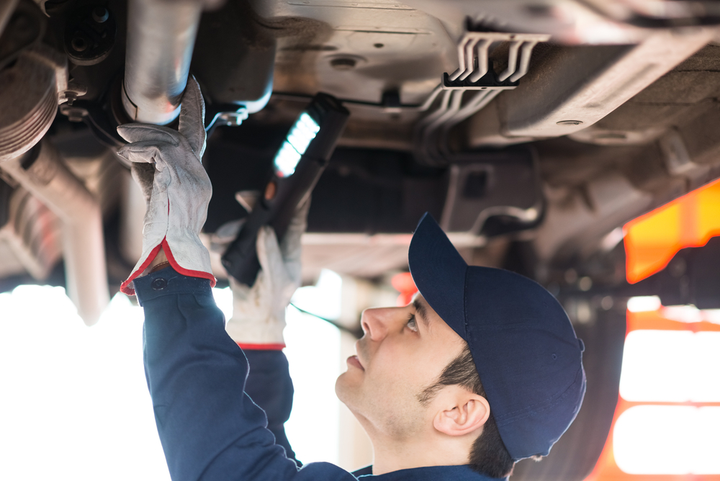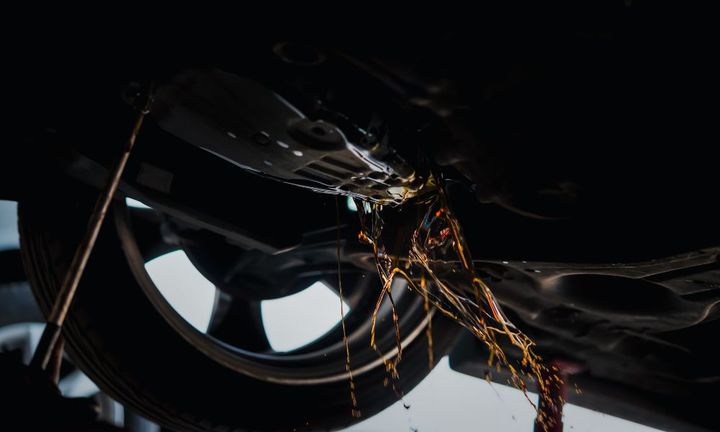


Transmission fluid is a specialized lubricant designed to meet the unique demands of a vehicle's transmission. It serves several vital purposes:
Lubrication: Transmission fluid lubricates the numerous moving parts within the transmission, such as gears, bearings, and clutch packs, reducing friction and wear.
Hydraulic Pressure: In automatic transmissions, the fluid acts as a hydraulic medium, providing the necessary pressure to engage and disengage clutches and bands, enabling smooth gear shifts.
Cooling: The constant meshing of gears and clutch engagement generates significant heat within the transmission. Transmission fluid helps dissipate this heat, preventing premature wear and potential damage.
Corrosion Protection: High-quality transmission fluids contain additives that protect internal components from corrosion and oxidation, extending the transmission's lifespan.

If you've ever caught a whiff of something burning while driving, and it smells a bit like overcooked french fries or burnt marshmallows, chances are you're dealing with a burning transmission fluid situation. This odor is a surefire indicator that your transmission is experiencing issues, and it's time to investigate further.
Let's dive into the main suspects that could be causing your transmission fluid to burn:
| Cause | Explanation |
|---|---|
| Low Fluid Level | When there's not enough fluid in the system, it can't properly lubricate and cool the transmission components. The remaining fluid gets overworked, overheats, and starts to burn. |
| Contaminated or Old Fluid | Over time, transmission fluid can become contaminated or break down due to heat and friction. This causes it to lose its lubricating properties, leading to increased friction, heat buildup, and fluid burning. |
| Fluid Leaks | A leak in the transmission system can cause the fluid level to drop gradually. As the level drops, the remaining fluid has to work harder, leading to overheating and burning. Leaks can be caused by worn seals, gaskets, or cracks in the transmission case. |
| Transmission Overheating | Sometimes, the burning smell isn't directly related to the fluid itself but rather to the transmission overheating. This can happen due to excessive towing, aggressive driving, or high-stress conditions that put extra strain on the transmission, causing the fluid to burn. |
Now that we know the potential causes, let's talk about how to diagnose the problem. Here are the steps I typically follow:
Check the fluid level and condition: With the engine warmed up and the vehicle on level ground, check the transmission fluid level and color. If it's low or looks burnt and discolored, that's a clear sign of an issue.
Look for leaks: Inspect the area around the transmission for any signs of fluid leaks. Sometimes, you can even spot the source of the leak, like a worn gasket or cracked seal.
Listen for unusual noises: If you hear whining, grinding, or humming noises coming from the transmission, it could indicate internal issues that are causing excessive heat and fluid burning.
Check for shifting problems: If your transmission is slipping gears or having difficulty shifting smoothly, it's another red flag that something's not right.
Scan for diagnostic codes: If all else fails, I'll hook up my trusty diagnostic scanner to check for any transmission-related fault codes. These codes can provide valuable clues about the root cause of the problem.
Once we've identified the culprit, it's time to roll up our sleeves and get to work. Here are some common repair procedures for each potential cause:
| Cause | Repair Procedure |
|---|---|
| Low Fluid Level | Top up the transmission fluid to the proper level, using the correct type and specification for your vehicle. Check for any leaks that might have caused the low level. |
| Contaminated or Old Fluid | Perform a complete transmission fluid flush and filter change to replace the old, burnt fluid with fresh, clean fluid. |
| Fluid Leaks | Locate and repair or replace the faulty component causing the leak (seal, gasket, or other component). Then refill the transmission with fresh fluid. |
| Transmission Overheating | Diagnose and repair or replace any faulty components causing the excessive heat buildup, such as a failed solenoid, worn clutches, or a damaged torque converter. After that, a fluid flush and refill will be necessary. |
Low Fluid Level: When the transmission fluid level is low, there's not enough fluid to properly lubricate and cool the internal components. This causes increased friction and heat buildup, which can lead to the fluid burning and producing that telltale smell. Topping up the fluid to the correct level should resolve the issue, but it's important to check for any leaks that might have caused the low level in the first place.
Contaminated or Old Fluid: Over time, transmission fluid can become contaminated with debris or break down due to the extreme heat and friction it's exposed to. When this happens, the fluid loses its lubricating and cooling properties, leading to increased friction and heat buildup within the transmission. This excessive heat can cause the fluid to burn, resulting in that dreaded burning smell. A complete fluid flush and filter change is necessary to replace the old, burnt fluid with fresh, clean fluid.
Fluid Leaks: If there's a leak in the transmission system, it can cause the fluid level to drop gradually. As the level drops, the remaining fluid has to work harder to lubricate and cool the transmission components, leading to overheating and burning. Leaks can be caused by various issues, such as worn seals, damaged gaskets, or even cracks in the transmission case itself. To fix this, you'll need to locate and repair or replace the faulty component causing the leak, and then refill the transmission with fresh fluid.
Transmission Overheating: In some cases, the burning smell isn't directly related to the fluid itself but rather to the transmission overheating. This can happen due to excessive towing, aggressive driving, or high-stress conditions that put extra strain on the transmission, causing it to generate excessive heat. When the transmission gets too hot, it can cause the fluid to burn and produce that telltale odor. To address this, you'll need to diagnose and repair or replace any faulty components that are causing the overheating, such as a failed solenoid, worn clutches, or a damaged torque converter. After that, a fluid flush and refill will be necessary to replace the burnt fluid with fresh, clean fluid.
Of course, the best way to avoid burning transmission fluid smells is to practice proper maintenance and prevention. Here are a few tips:

Follow your vehicle's recommended transmission fluid change intervals to the letter.
Avoid excessive towing, aggressive driving, or high-stress conditions that can overheat your transmission.
Check your transmission fluid level regularly and top it up if needed.
Have your transmission serviced by a professional at the first sign of any issues.
Now, let's talk about the elephant in the room: the cost of repairs. The truth is, the cost can vary widely depending on the underlying cause and the extent of the damage.
| Repair | Typical Cost Range |
|---|---|
| Fluid Top-up or Flush | $50 - $200 |
| Seal or Gasket Replacement | $300 - $800 |
| Major Internal Repairs or Rebuild | $1,500 - $4,000+ |
| Complete Transmission Replacement | $2,000 - $5,000+ |
A simple fluid top-up or flush might cost you anywhere from $50 to $200, while seal or gasket replacements could run you $300 to $800. But if we're talking about major internal repairs or a complete transmission rebuild, you're looking at a bill ranging from $1,500 to $4,000 or more. And in the worst-case scenario of needing a full transmission replacement, you could be facing a cost of $2,000 to $5,000 or higher.
I know, those numbers can be a tough pill to swallow, but trust me, it's better to address the issue promptly than to let it linger. Continuing to drive with a burning transmission fluid smell can lead to even more extensive and costly damage down the line.
Well, folks, there you have it – a mechanic's insider guide to tackling that pesky burning transmission fluid smell. Remember, if you ever catch a whiff of something burning while driving, don't ignore it. Take action right away to diagnose and address the issue before it escalates into a more significant (and more expensive) problem.
And as always, if you're ever unsure or uncomfortable tackling a transmission issue yourself, don't hesitate to bring your vehicle to a trusted professional mechanic. We're here to help keep your ride running smoothly and safely, one transmission at a time.
Happy motoring, and may your transmission fluid always stay cool and fresh!
The article does not cover how to optimize FAQ pages for voice search or how to measure the performance of an FAQ page. It also lacks information on using schema markup for FAQ pages.
An FAQ page aims to provide quick answers to common customer questions. It helps improve user experience and can drive more traffic through search engines.
Analyze customer support data and search for frequently asked questions. You can also look at competitor FAQ pages for inspiration.
It's recommended to have a dedicated FAQ page for better user experience. However, you can also incorporate an FAQ section within relevant pages.
Group related questions under clear categories or topics. Use accordion-style dropdowns for answers to allow easy scanning.
Use a conversational yet professional tone that matches your brand voice. Avoid jargon and keep the answers clear and concise.
Yes, an FAQ page can improve your SEO by targeting relevant keywords and satisfying search intent for common questions.
Regularly review and update your FAQ page, especially after product updates or when you receive new common questions.
Yes, visual aids like images, GIFs, or videos can enhance FAQ answers by providing clearer explanations or step-by-step guides.
Structure your questions and answers in a conversational way, using natural language. Incorporate potential voice search queries.

Sarah isn't your average gearhead. With a double major in Mechanical Engineering and Automotive Technology, she dived straight into the world of car repair. After 15 years of turning wrenches at dealerships and independent shops, Sarah joined MICDOT to share her expertise and passion for making cars run like new. Her in-depth knowledge and knack for explaining complex issues in simple terms make her a valuable asset to our team.












